Dull surfaces also reflect light like a mirror.
False : Only shiny surfaces reflect light like a mirror.
Topper's Solved these Questions
- LIGHT, SHADOWS AND REFLECTIONSBook:MTG IIT JEE FOUNDATIONChapter:LIGHT, SHADOWS AND REFLECTIONSExercise:EXERCISE (MATCH THE FOLLOWING)
Explore 3 Videos
- LIGHT, SHADOWS AND REFLECTIONSBook:MTG IIT JEE FOUNDATIONChapter:LIGHT, SHADOWS AND REFLECTIONSExercise:EXERCISE (ASSERTION & REASON TYPE)
Explore 10 Videos
- LIGHT, SHADOWS AND REFLECTIONSBook:MTG IIT JEE FOUNDATIONChapter:LIGHT, SHADOWS AND REFLECTIONSExercise:EXERCISE (FILL IN THE BLANKS)
Explore 8 Videos
- FUN WITH MAGNETSBook:MTG IIT JEE FOUNDATIONChapter:FUN WITH MAGNETSExercise:Olympaid/HOTS Corner
Explore 15 Videos
- MOTION AND MEASUREMENT OF DISTANCESBook:MTG IIT JEE FOUNDATIONChapter:MOTION AND MEASUREMENT OF DISTANCESExercise:OLYMPIAD/HOTS CORNER
Explore 15 Videos
Similar Questions
A light ray is incident on a plane mirror making an angle of 90∘ with the mirror's surface. The angle of reflection of the light is _______ .
View SolutionThe mirrors are perpendicular to each other as shown in the Fig. A light ray AB is incident on the mirror M1. Then the reflected ray will also suffer a reflection from the mirror M2). Then the final ray after reflection from M2 will be parallel to the incident ray, if -
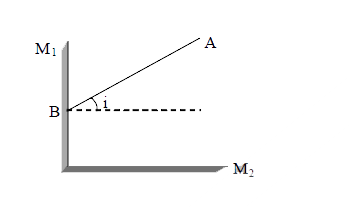
View Solution
Knowledge Check
First Surface Mirror:
Normally we use back surface mirrors. These are considered low precision mirrors because they actually have two reflecting surfaces. The first reflecting surface is the initial surface on the pane of glass where a small percentage of light is reflected off the surface. The second reflecting surface is the aluminium coating where a high percentage of light is reflected off the surface.
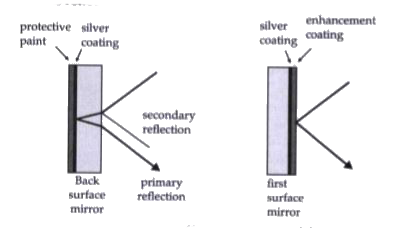
This dual reflection effect of a low precision mirror causes a loss of contrast and image distortion that is undesirable in high precision applications like rear projection systems, scanners and reflecting telescopes. In these cases good image quality is highly preferred, and this is where a front surface mirror is desired for clarity and single image reflection. First surface mirrors are quite common in professional optics. However, compared with back surface mirrors, they have the important disadvantage of being substantially more sensitive. The front surface may be touched, and a metal coating on the front surface is substantially more sensitive than a bare glass surface. For example, fingerprints can easily cause oxidation of the metal. Also, moisture or aggressive gases may cause oxidation of the mirror coating.
Light incident on back surface mirror suffers:Atwo reflections.Bone reflectionCtwo reflections and two refractions.Done refraction and one reflection.First Surface Mirror:
Normally we use back surface mirrors. These are considered low precision mirrors because they actually have two reflecting surfaces. The first reflecting surface is the initial surface on the pane of glass where a small percentage of light is reflected off the surface. The second reflecting surface is the aluminium coating where a high percentage of light is reflected off the surface.
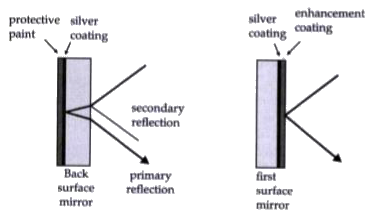
This dual reflection effect of a low precision mirror causes a loss of contrast and image distortion that is undesirable in high precision applications like rear projection systems, scanners and reflecting telescopes. In these cases good image quality is highly preferred, and this is where a front surface mirror is desired for clarity and single image reflection. First surface mirrors are quite common in professional optics. However, compared with back surface mirrors, they have the important disadvantage of being substantially more sensitive. The front surface may be touched, and a metal coating on the front surface is substantially more sensitive than a bare glass surface. For example, fingerprints can easily cause oxidation of the metal. Also, moisture or aggressive gases may cause oxidation of the mirror coating.
Precision of back surface mirrors is:Ahigh.Blow.Cdepends on intensity of light.Dsimilar to first surface mirror.First Surface Mirror:
Normally we use back surface mirrors. These are considered low precision mirrors because they actually have two reflecting surfaces. The first reflecting surface is the initial surface on the pane of glass where a small percentage of light is reflected off the surface. The second reflecting surface is the aluminium coating where a high percentage of light is reflected off the surface.
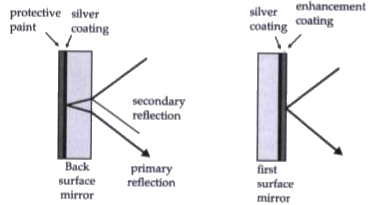
This dual reflection effect of a low precision mirror causes a loss of contrast and image distortion that is undesirable in high precision applications like rear projection systems, scanners and reflecting telescopes. In these cases good image quality is highly preferred, and this is where a front surface mirror is desired for clarity and single image reflection. First surface mirrors are quite common in professional optics. However, compared with back surface mirrors, they have the important disadvantage of being substantially more sensitive. The front surface may be touched, and a metal coating on the front surface is substantially more sensitive than a bare glass surface. For example, fingerprints can easily cause oxidation of the metal. Also, moisture or aggressive gases may cause oxidation of the mirror coating.
Image formed of front coated mirror:Asuffers astigmatismBis brilliantChas low contrastDis a dual image
A light ray is incident on a plane mirror making an angle of 90∘ with the mirror's surface. The angle of reflection of the light is _______ .
View SolutionDark, rough, and dull surfaces absorb radiation better than light, smooth, and shiny surfaces.
View SolutionReflection Of Light|Spherical Mirrors
View SolutionIf a ray of light incident on an opaque surface makes an angle of 30∘ with the mirror, what will be the angle of reflection of its corresponding reflected ray?
View SolutionFirst Surface Mirror:
Normally we use back surface mirrors. These are considered low precision mirrors because they actually have two reflecting surfaces. The first reflecting surface is the initial surface on the pane of glass where a small percentage of light is reflected off the surface. The second reflecting surface is the aluminium coating where a high percentage of light is reflected off the surface.
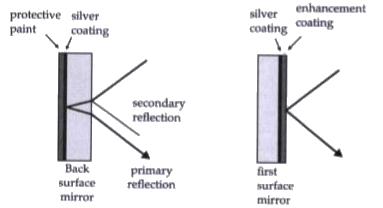
This dual reflection effect of a low precision mirror causes a loss of contrast and image distortion that is undesirable in high precision applications like rear projection systems, scanners and reflecting telescopes. In these cases good image quality is highly preferred, and this is where a front surface mirror is desired for clarity and single image reflection. First surface mirrors are quite common in professional optics. However, compared with back surface mirrors, they have the important disadvantage of being substantially more sensitive. The front surface may be touched, and a metal coating on the front surface is substantially more sensitive than a bare glass surface. For example, fingerprints can easily cause oxidation of the metal. Also, moisture or aggressive gases may cause oxidation of the mirror coating.
The front surface coating:
View Solution
